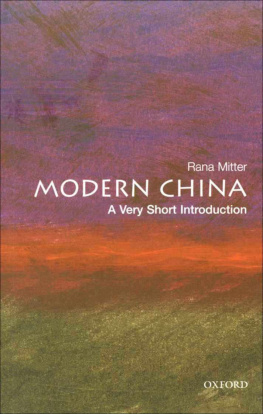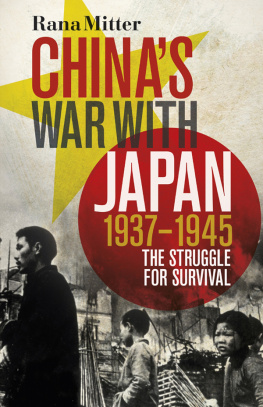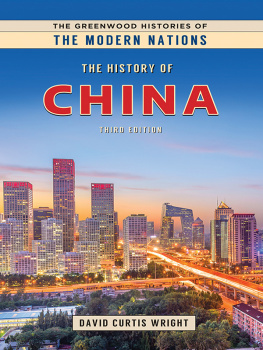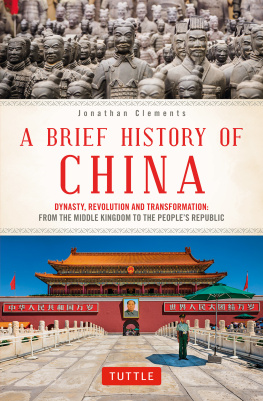
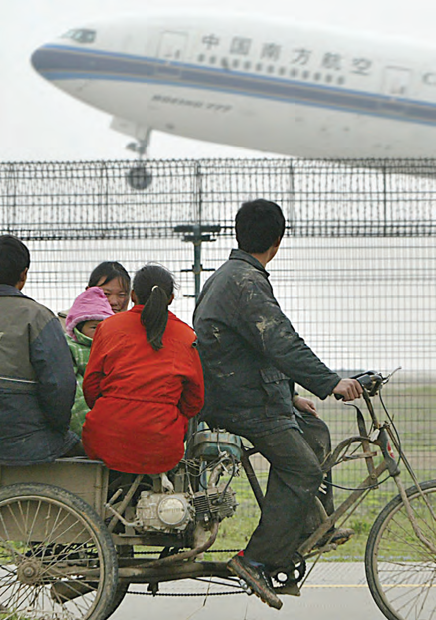
MODERN
CHINA

Rana Mitter


New York / London
www.sterlingpublishing.com
STERLING and the distinctive Sterling logo are registered trademarks of Sterling Publishing Co., Inc.
Library of Congress Cataloging-in-Publication Data
Mitter, Rana, 1969
Modern China / Rana Mitter.
p. cm. (A brief insight)
Includes bibliographical references.
ISBN 978-1-4027-6893-4
1. ChinaCivilization20th century. 2. ChinaCivilization21st century. 3. ChinaCivilizationWestern influences. 1. Title.
DS779.23.M57 2009
951.05dc22
2009013692
10 9 8 7 6 5 4 3 2 1
Published by Sterling Publishing Co., Inc.
387 Park Avenue South, New York, NY 10016
Published by arrangement with Oxford University Press, Inc.
2008 by Rana Mitter
Illustrated edition published in 2009 by Sterling Publishing, Co. Inc.
Additional text 2009 Sterling Publishing Co., Inc.
Distributed in Canada by Sterling Publishing
c/o Canadian Manda Group, 165 Dufferin Street
Toronto, Ontario, Canada M6K 3H6
Book design and layout: The DesignWorks Group
Please see picture credits on page 216 for image copyright information.
Manufactured in the United States
All rights reserved
Sterling ISBN 978-1-4027-6893-4
For information about custom editions, special sales, premium and corporate purchases, please contact Sterling Special Sales Department at 800-805-5489 or .
Frontispiece: Migrant laborers cycle past Pudong International Airport, Shanghai, China, in 2005- Millions of Chinese workers travel from the countryside to the cities to find employment and make a new life.
CONTENTS
I AM VERY GRATEFUL TO ALL those at Oxford University Press who commissioned this book and saw it through its various stages of life: Marsha Filion, Luciana OFlaherty, Deborah Protheroe, and James Thompson. Writing this book made copious reading necessary. I could not have easily made the time to do that reading and reflection without teaching relief funded by the generous grant of a Philip Leverhulme Prize by the Leverhulme Trust, for which I am immensely grateful. On-the-ground observations in 2006 were made possible by the kind award of a place on the British AcademyChinese Academy of Social Sciences exchange scheme. I also owe thanks to the anonymous reviewers who gave valuable comments both at proposal and manuscript stage. Colleagues and friends contributed in many ways to the book, but I must single out Graham Hutchings and Neil Pyper, who patiently read and commented on the whole of a very rough draft with wit and copious good sense. I have also had the constant support of my parents and Pamina. Katharine read and commented on the entire manuscript, and offered support in countless other ways. This book is dedicated to her.
THIS BOOK USES THE pinyin system of romanization of Chinese. Very approximately indeed, the transliterations that cause most problems for English-speakers are the following sounds:
cpronounced ts
xpronounced sh
qpronounced ch
And the sounds chi, zhi, ri, si, shi,and ziare pronounced as if the i sound is an rrso chr, zhr, and so forth.
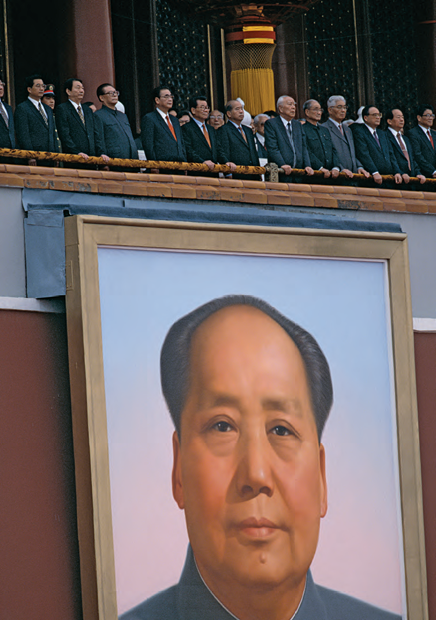
Peoples Republic of China leaders atop the Gate of Heavenly Peaceadorned with a portrait of Mao Zedongwatch the 1999 National Day parade celebrating the fiftieth anniversary of the PRCs founding.

It is impossible to do other than assent to the unanimous verdict that China has at length come to the hour of her destinyThe contempt for foreigners is a thing of the pastEven in remote places we have found the new spiritits evidence, strangely enough, the almost universal desire to learn Englishas knowledge of English is held to be the way to advancement, the key to a knowledge of the science and art, the philosophy and policy, of the West.
This assessment comes from the book New China by W. Y. Fullerton and C. E. Wilson. In the third decade of Chinas era of reform and opening-up (kaifang gaige), at last the clichs of the old Maoist erathe Chinese as worker ants mouthing xenophobic anti-imperialist slogans while all dressed in blue serge boiler-suitshave given way to impressions of a country whose cities are full of skyscrapers, whose rural areas are being transformed by new forms of land ownership and a massive rise in migrant labor, and whose population is keen to engage with the outside world after years of isolation. Fullerton and Wilsons observation that China is reaching the hour of her destiny, and that a significant part of the population are learning English as one way to fulfill that destiny, seems a reasonable comment on a China that is clearly very different from the one ruled a generation ago by Chairman Mao.
However, Fullerton and Wilson did not pen their observations having landed back at Kennedy or Heathrow airports on one of the many Air China 747s that ferry thousands of travelers daily between China and the West. They wrote their book a full century ago, and their reflections on what they subtitle a story of modern travel came at what, in retrospect, is a particularly poignant moment in Chinas history: the year 1910. The China they portray was lively, even optimistic, and very much engaged with the outside world. Yet within a year, the Qing dynasty, the last Chinese imperial house which still ruled the country that Fullerton and Wilson saw, had fallen. The revolution of October 1911 finally brought the two-thousand-year tradition of imperial rule in China to an end, making way for a Republic. That Republic would collapse less than forty years later, and would be succeeded in turn by a Peoples Republic whose own form would change over decades as it struggled to define what modern China was. It is a sign of how long it has taken for China to define its own vision of modernization that a travel description from the early twentieth century can still have resonance in the early twenty-first.
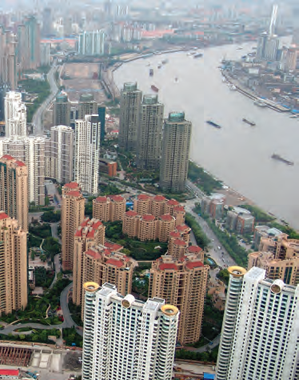
Shanghai is a cosmopolitan metropolis at the forefront of Chinas rapid economic development, which began in the early 1980s.
China is the worlds most populous country, with some 1.3 billion inhabitants at the beginning of the twenty-first century. Its economy grew in the first decade of this century by an average of around 10 percent a year. It is seeking a regional and global role, with a new political and economic presence in Africa, Latin America, and the Middle East, and has taken frequent steps to portray itself as a responsible member of the world community, playing a role in troublesome areas such as Iran and North Korea where the West has little sway. The 2008 Beijing Olympics mark the coming-out of China as an integrated member of the world community of nations, the acme of the peaceful rise which it has been engineering since the mid-1990s. The term peaceful rise (


